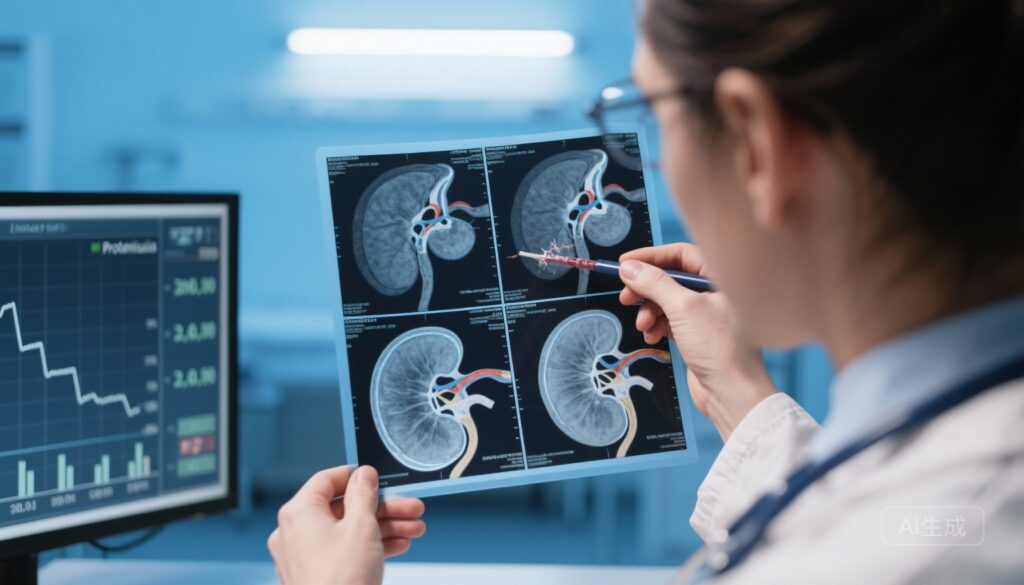Highlights
– In a prespecified interim analysis of the phase 3 ORIGIN trial, atacicept produced a 45.7% reduction in 24-hour urinary protein-to-creatinine ratio (UPCR) versus 6.8% with placebo at week 36 (between-group difference 41.8 percentage points; 95% CI, 28.9–52.3; P < 0.001).
– Three additional investigational agents—sibeprenlimab, cemdisiran, and felzartamab—reported phase 2 data showing meaningful antiproteinuric effects, but these data are smaller, of variable duration, and do not yet provide definitive evidence on kidney outcomes or long-term safety.
Background and disease burden
IgA nephropathy (IgAN) is the most common primary glomerulonephritis worldwide and remains a leading cause of progressive kidney failure. The disease is driven by production of galactose‑deficient IgA1, autoantibody formation, and mesangial deposition of IgA‑containing immune complexes, resulting in glomerular injury. Proteinuria is the principal modifiable risk factor for progression; reductions in proteinuria are associated with slower eGFR loss and lower risk of kidney failure. Yet many patients remain at high risk despite optimized supportive care including renin–angiotensin system blockade, blood‑pressure control, and increasingly SGLT2 inhibitors and lifestyle measures. There is therefore an urgent need for disease‑modifying therapies that address underlying immune drivers in high‑risk patients.
Study designs and interventions
Four recent clinical trials evaluated distinct biologic approaches in patients with biopsy‑confirmed, high‑risk IgAN on standard of care:
- Atacicept (phase 3, double‑blind, randomized, placebo‑controlled; ORIGIN): TACI‑Fc fusion protein that inhibits BAFF and APRIL; atacicept 150 mg subcutaneously weekly versus placebo. Primary endpoint: percentage change in 24‑hour UPCR at week 36. (Interim analysis n=203).
- Sibeprenlimab (phase 2, double‑blind, randomized, placebo‑controlled): IV sibeprenlimab at 2, 4, or 8 mg/kg monthly for 12 months vs placebo. Primary endpoint: change in log‑transformed 24‑hour UPCR at month 12 (n=155 randomized across four arms).
- Cemdisiran (phase 2, double‑blind, randomized 2:1): subcutaneous cemdisiran 600 mg every 4 weeks vs placebo for 36 weeks on background standard care. Primary endpoint: percentage change in 24‑hour UPCR at week 32 (n=31 randomized).
- Felzartamab (phase 2a, randomized, double‑blind, placebo‑controlled part 1 and open‑label part 2): multiple IV dosing schedules over 6 months; primary endpoint change in UPCR at 9 months; longer follow‑up assessed durability to 24 months in part 1 (small cohorts).
Key results — comparative summary
The following table summarizes primary efficacy and salient safety signals reported in each trial (data are taken from the published trial reports and prespecified interim analyses cited in the references):
| Agent (Phase) | Mechanism (as reported) | Sample size (reported) | Primary efficacy result (timepoint) | eGFR effect | Safety highlights | Trial ID / Funding |
|---|---|---|---|---|---|---|
| Atacicept (Phase 3, ORIGIN) | TACI‑Fc fusion protein; inhibits BAFF and APRIL | Interim analysis n = 203 (atacicept 106; placebo 97) | 24‑hr UPCR reduction at week 36: 45.7% (atacicept) vs 6.8% (placebo); between‑group difference 41.8 percentage points (95% CI, 28.9–52.3); P < 0.001 | Not reported in interim proteinuria primary analysis (safety and renal function assessed) | AEs in 59.3% (atacicept) vs 50.0% (placebo); mostly mild–moderate | NCT04716231; Funded by Vera Therapeutics |
| Sibeprenlimab (Phase 2, ENVISION) | Investigational monoclonal biologic (mechanism not specified in provided summary) | n = 155 (38, 41, 38 active dose arms; 38 placebo) | Geometric mean reduction in 24‑hr UPCR at 12 months: 47.2±8.2% (2 mg/kg), 58.8±6.1% (4 mg/kg), 62.0±5.7% (8 mg/kg) vs 20.0±12.6% (placebo) | Least‑squares mean ΔeGFR at 12 months: −2.7±1.8 (2 mg), 0.2±1.7 (4 mg), −1.5±1.8 (8 mg) vs −7.4±1.8 ml/min/1.73 m2 (placebo) | AEs 78.6% pooled active vs 71.1% placebo; safety profile similar across arms | NCT04287985; Funded by Visterra |
| Cemdisiran (Phase 2) | RNA interference therapeutic reducing hepatic C5 production (reported by authors) | n = 31 (cemdisiran 22; placebo 9) | Placebo‑adjusted geometric mean change in 24‑hr UPCR at week 32: −37.4% (cemdisiran vs placebo); spot UPCR consistent (−45.8%) | Not emphasized; primary outcomes focused on UPCR and serum C5 | Most AEs mild/mod; injection‑site reactions common (41%); large serum C5 reductions (~−99%) | Clin J Am Soc Nephrol 2024; trial details funded by investigators / collaborators as listed |
| Felzartamab (Phase 2a) | Investigational monoclonal antibody targeting plasma‑cell/B‑cell lineage (mechanistic class consistent with plasma‑cell targeting in published report) | Part 1: placebo n=12; felzartamab arms n=12, 11, 13; Part 2: n=6 (open‑label) | Least‑squares mean UPCR change at 9 months: placebo −5.7%; 2‑dose −12.5%; 5‑dose −12.8%; 9‑dose −29.5%; part 2 −44.8%. Sustained reduction at 24 months in 9‑dose arm (~−44.5%) | Smaller mean decreases in eGFR with felzartamab vs placebo through follow‑up | AEs predominantly grade 1–2; safety consistent with prior observations | Kidney Int. 2025; small cohorts, longer follow‑up reported |
Interpreting the results
Across these trials, the signal is consistent: targeting immune pathways implicated in IgAN can produce substantial and sometimes rapid reductions in proteinuria. The magnitude of proteinuria reduction reported with atacicept in the phase 3 interim analysis (≈46% geometric mean reduction) is similar to or greater than reductions reported with the active arms of the phase 2 studies of sibeprenlimab, cemdisiran, and felzartamab. Notably, sibeprenlimab and felzartamab reported durable proteinuria reductions out to 12–24 months in some cohorts, and cemdisiran produced large reductions in serum C5 (consistent with pharmacodynamic effect) and clinically meaningful decreases in UPCR at 32 weeks.
However, several important caveats apply:
- Most phase 2 studies are small and may be susceptible to selection effects, regression to the mean, and imbalances that affect proteinuria outcomes; confirmation in larger randomized trials is required.
- Proteinuria reduction is an accepted surrogate for disease progression in IgAN, but it is not equivalent to demonstration of preserved kidney function or reduction in hard endpoints such as a sustained eGFR decline or kidney failure. The atacicept data are an interim analysis of a phase 3 trial; full trial results and longer‑term renal outcomes are essential.
- Different trials used different durations, dosing regimens, and endpoints (24‑hour vs spot UPCR; month 9, 12, 32, 36), which complicates direct comparison.
- Safety profiles will be critical for clinical adoption. Targeting B‑cell pathways, plasma cells, or complement carries theoretical and observed risks (infections, hypogammaglobulinemia, vaccine response impairment, infusion/injection reactions). Serious adverse events were not prominent in these reports, but larger and longer studies are needed to estimate rare or delayed risks.
Mechanistic and translational considerations
Atacicept blocks BAFF and APRIL — cytokines central to B‑cell survival and plasma‑cell differentiation — offering biological plausibility for reduced IgA production and lowered pathogenic immune complex formation. Cemdisiran, an RNA interference agent, markedly reduced serum C5, implicating terminal complement blockade as another therapeutic approach to interrupt complement‑mediated glomerular injury in IgAN. Felzartamab’s durable reductions in proteinuria are consistent with plasma‑cell targeting, which could reduce pathogenic IgA autoantibody production. The mechanism for sibeprenlimab was not specified in the summary provided, but its effect on proteinuria and relatively preserved eGFR suggest activity on disease drivers in IgAN.
Expert commentary and limitations
Opinion leaders in IgAN will likely view the atacicept phase 3 interim results as an important proof of concept that BAFF/APRIL pathway inhibition can meaningfully reduce proteinuria in high‑risk patients. Nonetheless, the community will watch for complete phase 3 outcomes including sustained eGFR trajectories, rates of clinical remission, safety (particularly infections and immunoglobulin changes), and subgroup effects (e.g., baseline proteinuria, histologic features, concomitant medications).
Key limitations across the program include variability in trial size and duration, reliance on proteinuria as the primary outcome for phase 2 studies, and limited data on longer‑term kidney protection and safety. Biomarkers (e.g., serum IgA1 glycosylation, complement activation markers) and histologic correlates will be important to understand which patients derive the most benefit and to refine patient selection.
Clinical implications and future directions
If the final atacicept phase 3 results confirm a sustained antiproteinuric effect with acceptable safety and demonstrate preservation of eGFR or reduced risk of kidney‑failure events, atacicept could become the first approved targeted biologic for IgAN that modulates BAFF/APRIL signaling. The phase 2 signals from sibeprenlimab, cemdisiran, and felzartamab are encouraging and justify progression to larger, longer trials focused on kidney outcomes and robust safety monitoring.
Practically, several questions must be answered before routine use: which patients (degree of proteinuria, histologic risk, prior immunosuppression) benefit most; whether combination with existing therapies (SGLT2 inhibitors, RAAS blockade) is additive or redundant; optimal duration of therapy and retreatment strategies; and vaccination or prophylactic measures to mitigate infection risk.
Conclusion
Recent trials demonstrate that targeting B‑cell/plasma‑cell biology and complement can produce substantial reductions in proteinuria in IgA nephropathy. The phase 3 interim result for atacicept is the most advanced evidence to date, showing a robust antiproteinuric effect at 36 weeks. Smaller phase 2 trials of sibeprenlimab, cemdisiran, and felzartamab also report meaningful reductions in proteinuria and, in some cases, durable responses. The field now needs full phase 3 outcomes, longer follow‑up for kidney function and safety, and comparative studies to define optimal agents, patient selection, and treatment algorithms.
Funding and clinicaltrials.gov
Atacicept ORIGIN phase 3: Funded by Vera Therapeutics; ClinicalTrials.gov number NCT04716231 (as reported in the NEJM article).
Sibeprenlimab ENVISION phase 2: Funded by Visterra; ClinicalTrials.gov number NCT04287985; EudraCT 2019‑002531‑29 (as reported).
Cemdisiran phase 2: Reported in Clin J Am Soc Nephrol 2024; funding and trial identifiers are provided in the published report referenced below.
Felzartamab phase 2a: Reported in Kidney International 2025; details of funding and trial registration are provided in the publication.
References
1. Lafayette R, Barbour SJ, Brenner RM, et al. A Phase 3 Trial of Atacicept in Patients with IgA Nephropathy. N Engl J Med. 2025 Nov 6. doi: 10.1056/NEJMoa2510198 IF: 78.5 Q1 . Epub ahead of print. PMID: 41196369 IF: 78.5 Q1 .
2. Mathur M, Barratt J, Chacko B, et al.; ENVISION Trial Investigators Group. A Phase 2 Trial of Sibeprenlimab in Patients with IgA Nephropathy. N Engl J Med. 2024 Jan 4;390(1):20‑31. doi: 10.1056/NEJMoa2305635 IF: 78.5 Q1 . PMID: 37916620 IF: 78.5 Q1 .
3. Barratt J, Liew A, Yeo SC, et al. Phase 2 Trial of Cemdisiran in Adult Patients with IgA Nephropathy: A Randomized Controlled Trial. Clin J Am Soc Nephrol. 2024 Apr 1;19(4):452‑462. doi: 10.2215/CJN.0000000000000384 IF: 7.1 Q1 . PMID: 38214599 IF: 7.1 Q1 ; PMCID: PMC11020434 IF: 7.1 Q1 .
4. Floege J, Lafayette R, Barratt J, et al. Randomized, double‑blind, placebo‑controlled phase 2a study assessing the efficacy and safety of felzartamab for IgA nephropathy. Kidney Int. 2025 Oct;108(4):695‑706. doi: 10.1016/j.kint.2025.05.028 IF: 12.6 Q1 . PMID: 40581166 IF: 12.6 Q1 .
Author note
This article synthesizes interim and published results from trials of atacicept, sibeprenlimab, cemdisiran, and felzartamab in IgA nephropathy. Numbers and trial identifiers are reported as presented in the original publications cited above.



